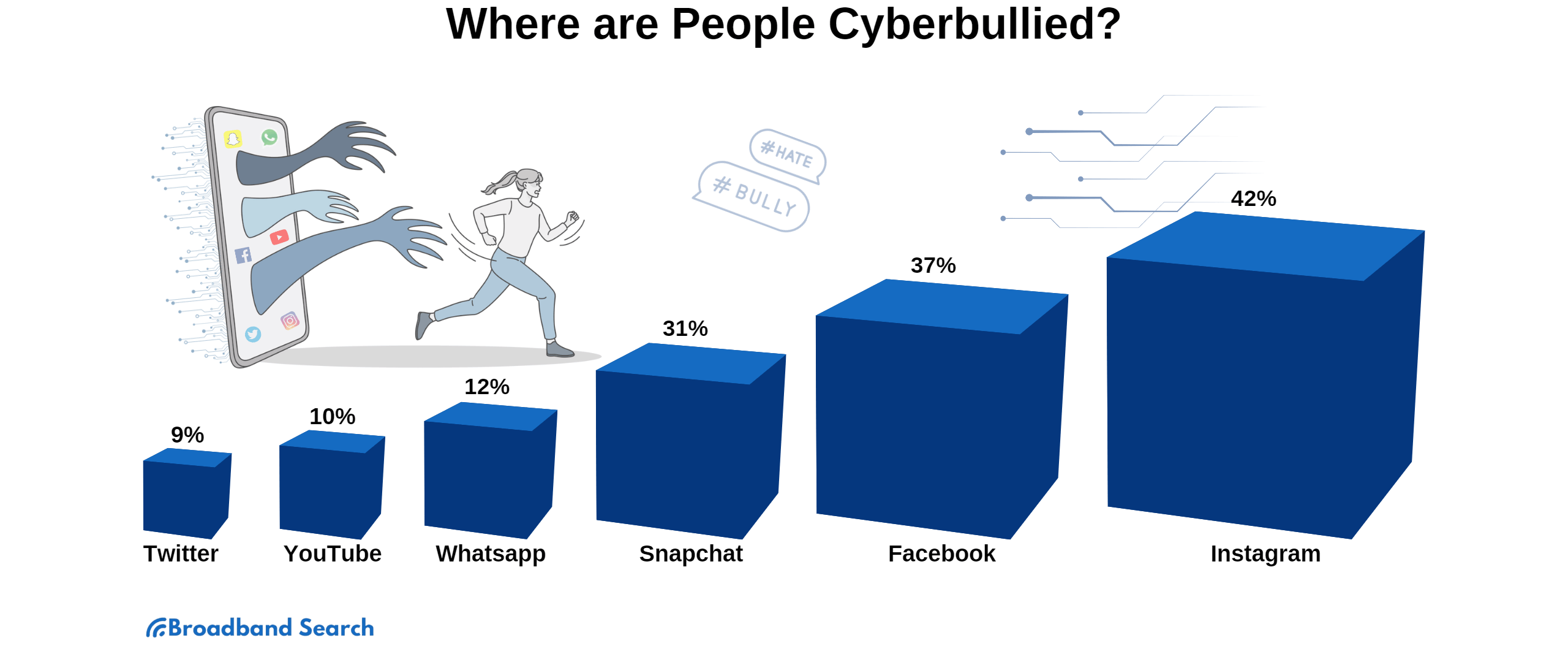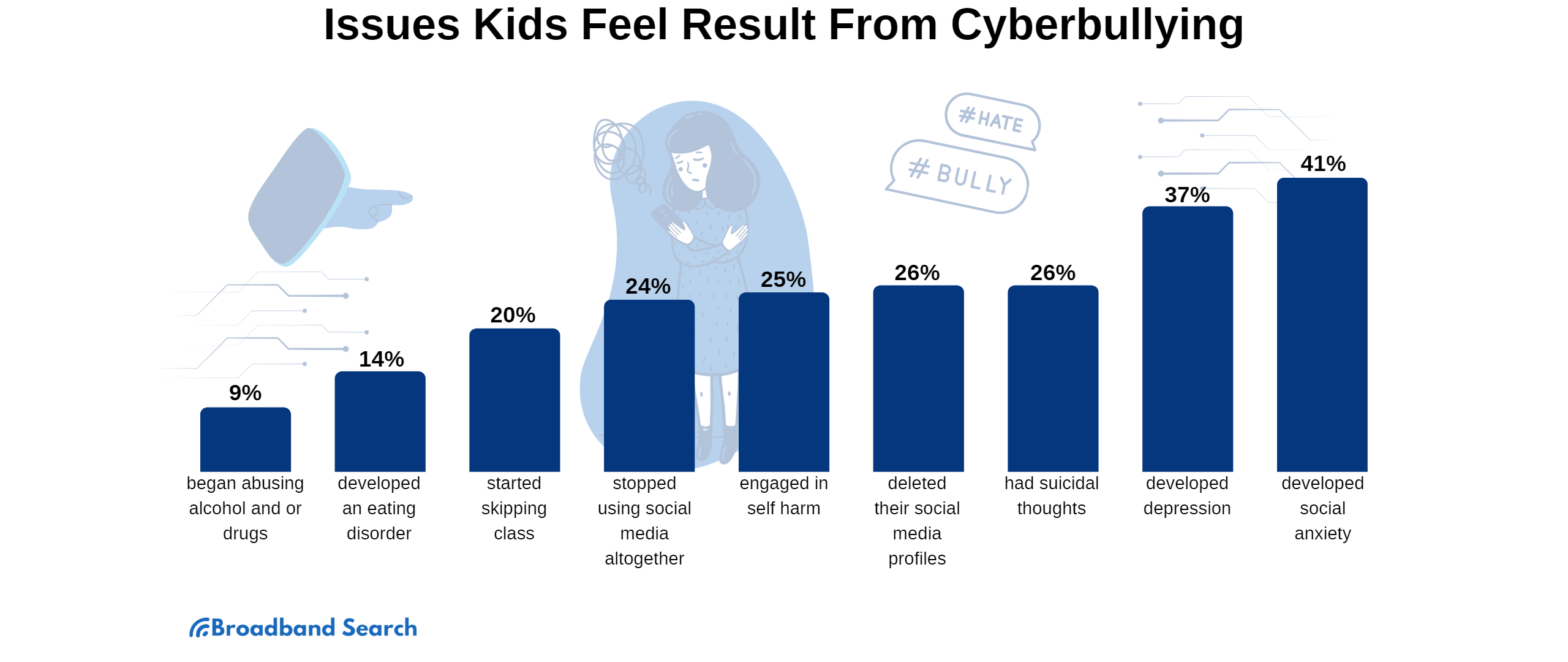As our lives become increasingly digital, the risk of online harassment grows. To help readers understand how this issue is evolving, BroadbandSearch has compiled the latest cyberbullying statistics, tracking trends across different platforms, regions, and demographics.
Digital technology often makes our lives easier, improving business, communication, and entertainment. However, this increased connectivity has a downside: cyberbullying.
What Is Cyberbullying?
Cyberbullying is bullying that occurs in digital spaces, such as on mobile phones, computers, and tablets. It can happen through text messages, on social media, in forums, or during online gaming. It's an age-old problem that has found a new, often more damaging, outlet.
Unlike in-person bullying, cyberbullying can happen anytime and often goes unnoticed because it occurs in digital spaces.
What Is the Difference Between Cyberbullying and Cyberharassment?
While often used interchangeably, these terms have distinct meanings.
- Cyberbullying typically refers to repeated, intentional harm among young people using electronic communication.
- Cyberharassment is a broader term that includes adults and can occur in various contexts, such as the workplace or political discussions.
How Has Cyberbullying Changed Over Time?
The Cyberbullying Research Center tracked trends from 2016 to 2025 and revealed a significant increase in online harassment.
- Lifetime victimization (the experience of being a target of online harassment at any point during a person's life): Rose from 33.6% in 2016 to 58.2% in 2025.
- 30-day victimization: Increased from 16.5% in 2016 to 32.7% in 2025.
- Offending (engaging in the behavior of bullying others online through electronic devices like computers and cell phones): Jumped from around 5-6% between 2015 and 2021 to 16.1% in 2025.
Newer risks, like AI-generated deepfakes and poor content moderation in less common languages, are making digital spaces even more complex to navigate.

Key Cyberbullying Statistics for 2025
The following data highlights the scale of cyberbullying and its impact on different regions and demographics.
Which Social Media Platforms Have the Highest Rates of Cyberbullying?
According to Exploding Topics, Instagram and Facebook are the platforms where users experience the most cyberbullying.
- Instagram: ~29.8%
- Facebook: ~26.2%
- Snapchat: ~22%
- WhatsApp: ~8.5%
- YouTube: ~7.1%
- Twitter/X: ~6.4%

What Are the Most Common Types of Cyberbullying?
Data from Exploding Topics shows that posting mean or hurtful content is the most frequent form of online harassment.
- Mean/hurtful posts: ~77.5%
- Spreading rumors: ~70.4%
- Exclusion from chats/groups: ~66.4%
- Repeated unwanted contact: ~55.5%
Where Is Cyberbullying Most Common?
Cyberbullying is a global issue, but its prevalence varies by country. A 2025 report from SQ Magazine shows:
- Brazil: ~41% of youth have witnessed cyberbullying.
- India: ~37% of teens have experienced cyberbullying.
- Europe: ~31% of teens have experienced cyberbullying.
- Japan: ~15% of teens have experienced cyberbullying.
Who Is Most Affected by Cyberbullying?
While anyone can be a target, certain demographics face a higher risk.

Age, Gender, and LGBTQ+ Youth
Cyberbullying is most common during middle school years.
- Middle school: ~37% experience it weekly.
- High school: ~25% experience it weekly.
- Elementary school: ~6% experience it weekly.
Females are generally more affected than males. LGBTQ+ youth who are bullied face a significantly higher risk of suicide attempts.
Adults and Minority Groups
Cyberbullying also affects adults.
- In Canada, 44% of women and gender-diverse individuals have faced online hate, with 30% of Indigenous women reporting unwanted online behavior.
- In the U.S., 50% of Black adult gamers have been harassed due to their race.
- To combat this, the U.S. government has allocated $36 million for victims of cybercrime and another $15 million to address tech-based gender violence.
The Impact of Cyberbullying
The effects of cyberbullying can be severe, impacting mental health, well-being, and academic performance.
Victims are more likely to experience:
- Depression, anxiety, and sleep issues.
- Decline in academic performance.
- Suicidal thoughts.
According to the Cyberbullying Research Center, 64% of victims say it affects their ability to learn and feel safe at school. Furthermore, bullied students are twice as likely to experience physical symptoms like headaches and stomach aches.
How to Recognize and Respond to Cyberbullying
Knowing the signs of cyberbullying is the first step toward intervention.
How to Tell if Someone Is Being Cyberbullied
Victims of cyberbullying often don't speak up, so it's important to recognize behavioral changes. According to the National Crime Prevention Center (NCPC), someone being cyberbullied may:
- Become withdrawn, anxious, or moody.
- Act more aggressively.
- Protest going to school or experience a drop in academic performance.
- Stop using their computer or other devices.
- Change their eating or sleeping habits.
- Attempt self-harm or threaten suicide.
If you notice a sudden change in behavior, especially regarding device usage, it's crucial to ask what's going on.

How to Recognize a Cyberbully
It's also important to identify signs that someone may be engaging in cyberbullying. A person who is cyberbullying others might:
- Quickly hide their screen when someone approaches.
- Appear nervous or jumpy while online.
- Be secretive about their online activities.
- Excessive device usage.
- Become angry when internet privileges are taken away.
What to Do if You Suspect Cyberbullying
Around 81% of kids think bullying is easier to get away with online, partly because 90% of those who see it happen simply ignore it. However, taking action can make a difference.
If you believe a child is a victim, consider these steps:
- Talk to them about what cyberbullying is and ensure they know they won't lose their internet access for speaking up.
- Involve teachers and school administrators to address the issue.
- Encourage bystanders to report abuse and support the victim.
Prevention Strategies
Taking proactive steps can help prevent cyberbullying before it starts:
For Parents and Educators:
- Teach digital citizenship and online etiquette early
- Set clear expectations about respectful online behavior
- Create open communication channels about online experiences
- Monitor online activities age-appropriately
- Use parental control tools and privacy settings
For Organizations:
- Implement comprehensive anti-bullying policies that include cyberbullying
- Provide regular training on digital citizenship
- Create safe reporting mechanisms
- Foster inclusive environments that celebrate diversity
Helplines
- StopBullying.gov: A federal government website with resources, advice, and a help center for reporting and responding to bullying and cyberbullying. The Agency Contact Center phone number is 1-877-696-6775.
- STOMP Out Bullying™: A leading national anti-bullying and cyberbullying organization. For youth ages 13–24, their confidential HelpChat Crisis Line is available online. You can also call to make a donation or for general information at 1-877-N0BULLY (602-8559).
- The Trevor Project: A national organization that provides crisis intervention and suicide prevention services to LGBTQ young people. Their Lifeline number is 1-866-488-7386.
- Cyberbullying Research Center: Provides information and resources for parents, educators, and students on the nature and extent of cyberbullying.
- ConnectSafely: A nonprofit organization dedicated to promoting online safety and digital citizenship. Offers articles and resources for families and educators
Final Thoughts: Notice and Deter Cyberbullying
Cyberbullying is a serious issue that affects people of all ages worldwide. By understanding the statistics and knowing how to respond, we can all play a role in creating safer digital communities. If you see harmful behavior online, say something—it could make a significant difference.
FAQ
Which group has the highest risk of being cyberbullied?
The most likely demographic to be cyberbullied is a white, homosexual, 9th-grade girl.
Which group has the highest chance of being a cyberbully?
Strangely, or perhaps not, it turns out that girls tend to be the cyberbully most often as well, especially towards their former friends or dating partners. More research is needed in this area, but these are the initial results.
Does a single incident count as bullying?
Technically, no. An important part of defining either bullying or cyberbullying is its repetitive nature. Though a single instance can certainly be painful, it is not defined as bullying until it has been shown to happen recurrently.
Can adults get cyberbullied?
The Cyberbullying Research Center says cyberbullying as a term should generally only be applied to interactions between adolescent peers. While the same behaviors can certainly happen between adults, there is a distinction between that and when it happens to kids. For adults, the behavior is actually a crime like harassment or stalking.
What are the most common types of cyberbullying?
This is not a conclusive list, but the most frequent type of cyberbullying takes the form of flaming, outing, trolling, name calling, spreading false rumors, sending explicit images or messages, or cyberstalking (harassing or making physical threats).

